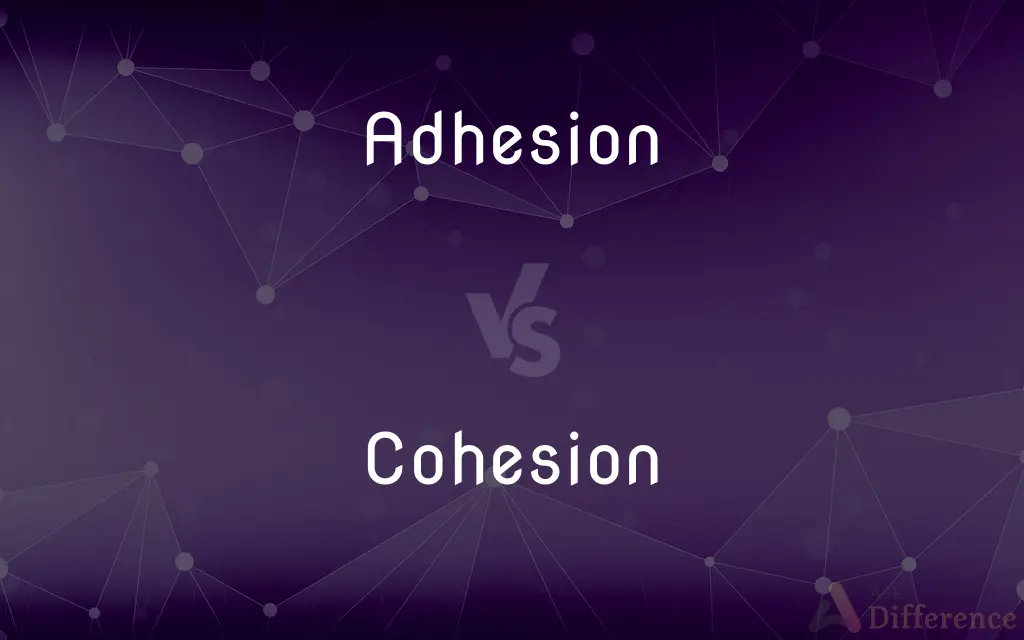Adhesion vs. Cohesion — What's the Difference?
By Tayyaba Rehman — Updated on September 22, 2023
Adhesion refers to the attraction between different substances, while cohesion concerns the attraction between like molecules of the same substance.

Difference Between Adhesion and Cohesion
Table of Contents
ADVERTISEMENT
Key Differences
Adhesion and cohesion are fundamental concepts in the realm of physics and chemistry, especially when discussing the behavior of liquids. Adhesion pertains to the attractive force between two different substances or materials. For example, when water droplets stick to a windowpane, it's the force of adhesion at work.
On the other hand, cohesion refers to the attraction that occurs between like molecules of the same substance. An illustrative example of this is the way water molecules are drawn to one another, creating surface tension on the water's surface, allowing small insects to seemingly "walk" on water.
Both adhesion and cohesion play vital roles in capillary action, a phenomenon where liquid moves against the force of gravity in narrow spaces. Adhesion causes the liquid to cling to the walls of the tube, while cohesion keeps the liquid molecules together as they rise.
Interestingly, the balance between adhesion and cohesion can affect how liquids behave. If adhesion is stronger than cohesion, a liquid will spread out. Conversely, if cohesion dominates, the liquid will form droplets or beads. Observing the behavior of water on various surfaces, such as waxed cars or plant leaves, showcases the interplay between these two forces.
Comparison Chart
Definition
Attraction between different substances
Attraction between like molecules of the same substance
ADVERTISEMENT
Example
Water sticking to glass
Water droplets merging together
Role in Capillary Action
Makes liquid stick to tube walls
Pulls liquid molecules together
Behavior
Can cause liquids to spread out
Can cause liquids to form droplets
Relation to Surface Tension
Influences wetting properties
Main force behind surface tension
Compare with Definitions
Adhesion
Opposite of repulsion between disparate materials.
Adhesion causes the wet paper to adhere to the wood.
Cohesion
Attraction among molecules of a single substance.
Thanks to cohesion, mercury forms spherical beads on a flat surface.
Adhesion
Integral for binding agents in various applications.
The strong adhesion of glue binds paper and cardboard effectively.
Cohesion
Responsible for the integrity of certain forms of matter.
Cohesion ensures that a sugar cube maintains its shape.
Adhesion
Determines how substances interact on contact.
Water shows strong adhesion when spreading on certain surfaces.
Cohesion
Force that holds similar molecules together.
Cohesion allows water to form droplets on a surface.
Adhesion
Adhesion is the tendency of dissimilar particles or surfaces to cling to one another (cohesion refers to the tendency of similar or identical particles/surfaces to cling to one another). The forces that cause adhesion and cohesion can be divided into several types.
Cohesion
Reason behind surface tension in liquids.
The high cohesion in water creates a surface that small bugs can skate on.
Adhesion
The process or condition of sticking or staying attached
The adhesion of the glue to wood.
Cohesion
Opposite of separation in similar substances.
The cohesion of metal atoms gives rise to its solid state.
Adhesion
(Physics) The physical attraction or joining of two substances, especially the macroscopically observable attraction of dissimilar substances.
Cohesion
The act, process, or condition of cohering
Exhibited strong cohesion in the family unit.
Adhesion
A condition in which bodily tissues that are normally separate grow together.
Cohesion
(Physics) The intermolecular attraction by which the elements of a body are held together.
Adhesion
A fibrous band of scar tissue that binds together normally separate anatomical structures.
Cohesion
(Botany) The congenital union of parts of the same kind, such as a calyx of five united sepals.
Adhesion
Attachment or devotion, as to a religion or belief.
Cohesion
State of cohering, or of working together.
Unit cohesion is important in the military.
Adhesion
The ability of a substance to stick to an unlike substance.
Cohesion
Various intermolecular forces that hold solids and liquids together.
Adhesion
Persistent attachment or loyalty.
Cohesion
(biology) Growing together of normally distinct parts of a plant.
Adhesion
An agreement to adhere.
Cohesion
(software engineering) Degree to which functionally related elements in a system belong together.
Adhesion
(medicine) An abnormal union of surface by the formation of new tissue resulting from an inflammatory process.
Cohesion
(linguistics) Grammatical or lexical relationship between different parts of the same text.
Adhesion
(biochemistry) The binding of a cell to a surface or substrate.
Cohesion
The act or state of sticking together; close union.
Adhesion
The frictional grip on a surface, of wheels, shoes etc.
Cohesion
That from of attraction by which the particles of a body are united throughout the mass, whether like or unlike; - distinguished from adhesion, which unites bodies by their adjacent surfaces.
Solids and fluids differ in the degree of cohesion, which, being increased, turns a fluid into a solid.
Adhesion
The action of sticking; the state of being attached; intimate union; as, the adhesion of glue, or of parts united by growth, cement, or the like.
Cohesion
Logical agreement and dependence; as, the cohesion of ideas.
Adhesion
Adherence; steady or firm attachment; fidelity; as, adhesion to error, to a policy.
His adhesion to the Tories was bounded by his approbation of their foreign policy.
Cohesion
The state of cohering or sticking together
Adhesion
Agreement to adhere; concurrence; assent.
To that treaty Spain and England gave in their adhesion.
Cohesion
(botany) the process in some plants of parts growing together that are usually separate (such as petals)
Adhesion
The molecular attraction exerted between bodies in contact. See Cohesion.
Cohesion
(physics) the intermolecular force that holds together the molecules in a solid or liquid
Adhesion
Union of surface, normally separate, by the formation of new tissue resulting from an inflammatory process.
Adhesion
The union of parts which are separate in other plants, or in younger states of the same plant.
Adhesion
Abnormal union of bodily tissues; most common in the abdomen
Adhesion
A fibrous band of scar tissue that binds together normally separate anatomical structures
Adhesion
The property of sticking together (as of glue and wood) or the joining of surfaces of different composition
Adhesion
Faithful support for a religion or cause or political party
Adhesion
The force of attraction between different kinds of molecules.
The adhesion of paint to a wall ensures it stays in place.
Adhesion
A phenomenon where one substance clings to another.
Due to adhesion, the label sticks firmly to the bottle.
Common Curiosities
Can adhesion occur between two liquids?
Yes, if the liquids are miscible and attract each other, adhesion occurs.
Are adhesion and cohesion the same?
No, adhesion involves different substances, while cohesion involves the same substance.
How does soap affect surface tension?
Soap reduces water's cohesion, thereby reducing its surface tension.
What causes water droplets to form?
Cohesion pulls water molecules together, leading to droplet formation.
Why do certain liquids bead up?
Strong cohesion and weak adhesion can cause liquids to bead.
Why does water spread on some surfaces?
Strong adhesion between water and the surface causes spreading.
Is cohesion stronger in solids or liquids?
Generally, cohesion is stronger in solids than in liquids.
How does temperature influence cohesion?
Increased temperature can decrease cohesion in many liquids.
Why don't oil and water mix?
Differences in adhesion and cohesion properties cause immiscibility.
Which force is responsible for meniscus formation in tubes?
Both adhesion and cohesion play roles in meniscus formation.
Why does water climb a capillary tube?
Due to the combined effects of adhesion (to the tube) and cohesion (within the water).
What's the relation between cohesion and viscosity?
Stronger cohesion often results in higher viscosity in liquids.
Can adhesion exist without cohesion?
Yes, adhesion can exist independently, depending on the substances involved.
Which is more dominant, adhesion or cohesion?
It depends on the substances and conditions in question; neither is universally dominant.
Can materials be designed to increase adhesion?
Yes, surface treatments and adhesion promoters can enhance adhesion.
Share Your Discovery

Previous Comparison
Ashen vs. Dusky
Next Comparison
Unitard vs. LeotardAuthor Spotlight
Written by
Tayyaba RehmanTayyaba Rehman is a distinguished writer, currently serving as a primary contributor to askdifference.com. As a researcher in semantics and etymology, Tayyaba's passion for the complexity of languages and their distinctions has found a perfect home on the platform. Tayyaba delves into the intricacies of language, distinguishing between commonly confused words and phrases, thereby providing clarity for readers worldwide.
















































